A Long Time Ago... #14
Hello there.
Welcome to the fourteenth of these posts exploring art, fiction and history. Every other Sunday I’ve been sharing some insights into my two major passions - Star Wars and history, or specifically, ancient art.
Art as a means of representation, observation and meaning, has survived tens of thousands of years, expressed now in a mesmerising multitude of ways. I'm fascinated by its origins, and a particular subgenre of art known as the Star Wars franchise - these two interests combined for my first Star Wars Insider article ART WARS, found in issue #226.
I’m expressing and sharing this fascination for a final time in this format with the second half of my timeline order of Marvel’s 2015-onwards Star Wars comics, as well as a final ancient art site that will serve as the basis for a story one day.
Starting on Sunday 20th October, I’ll be inviting guests on to continue the series with their favourite Star Wars stories and historical sites! But without further ado, let’s go, for a final time from me, A Long Time Ago…
In A Galaxy Far, Far Away…

That’s a view (from the other end of the timeline this time) of the many folders of single issue and trade paperback Star Wars comics from Marvel since 2015 in my collection, nearly all of the Skywalker Saga stories. But since photographing my storage system in detail, and breaking down each issue or paperback would take a long time, I’m just sharing a brief chronological reading order which started in #13 of this series.
‘Brief’, so I won’t be naming the many many talented creators, or explain the back and forths and overlappings between the longer ongoing series (there are way better and more comprehensive lists - that even go panel by panel!).
Star Wars (fifty issues) follows straight on from The Empire Strikes Back, starting with Luke and the Rebellion dealing with the aftermath of that film and then ploughing forwards on many adventures bridging the year-long gap until the next film, with more of a Lando-focus as Han is well… in carbonite.
Darth Vader (fifty issues) again picks up straight after Luke’s refusal, with ties not only deeper into Vader’s past but also looking to the future of the Sith as seen in The Rise of Skywalker. This year there was a Free Comic Book Day issue with both a Star Wars and Darth Vader story.
Doctor Aphra (forty issues) continued simultaneous with the above two, following Aphra with a new crew on various missions after the conclusion of the previous series.
Bounty Hunters (forty-two issues) was the new ongoing series in this time period, fitting in with the three above series and following hunters old and new with a focus on Beilert Valance who I mentioned last time, a character who, in appearance at least, got his start in the old Legends canon.
War of the Bounty Hunters (six issues, Alpha and 1-5) was the first of four crossover events that were miniseries in their own right, pulling in characters from the four main series and more whilst the ongoings showed their deeper reactions and exploits and ripples from the main events.
This series is probably my favourite comic event, centring on an auction for Han Solo in carbonite that involves so many major players. There were also four standalone issues that tied to the event, focussing on players in the galaxy’s criminal underworld: Jabba the Hutt, 4-LOM and Zuckuss, Boussh and IG-88. This was the event that someone broke down panel by panel as the same moment could be captured five times or more from different angles!
Crimson Reign (five issues) continued the trend and was the second in the much more apparent trilogy of miniseries crossover events focussing on Qi’ra (and the organisation Crimson Dawn) from the film Solo, whose journey had been left on a cliffhanger.
Hidden Empire (five issues) completed that trilogy (which I have yet to read), seeing Crimson Dawn face the Empire - I’m excited to read how this all ties into the ongoings too!
Sana Starros (five issues) takes place amidst all these ongoings and miniseries in the year between films, following Han Solo’s ex-wife, a great character from the 2015-2020 Star Wars series, on an adventure with her family.
Dark Droids (five issues) is the last major event in this year, seeing all the technology in the galaxy taken over from a single droid called the Scourge, tying into the four ongoings including the penultimate issues of Doctor Aphra and Bounty Hunters.
The event also included the four issue series D-Squad, the revival of a team of droids from The Clone Wars animated show, but with a new roster led by R2-D2.
Revelations is the title of two separate single issues which mostly take place at this time. The first takes places before Hidden Empire, a narrative following Vader with visions of future stories. The second was an anthology with short stories teeing up the new line of Marvel titles across eras.
Scoundrels, Rebels and the Empire (six issues) is the name of the trade paperback collecting six one-shots tying into Return of the Jedi for the film’s 40th anniversary, with characters ranging from all three groups: Jabba’s Palace, Ewoks, Lando, The Empire, The Rebellion and Max Rebo.
Darth Vader: Black, White and Red (four issues) is an anthology series in the same vein as the Maul one I mentioned last time, but with an ongoing story and single issue ones that jump around the timeline, so I’ve placed it here in a way as an epilogue to the image that is Vader after his end in Episode VI.
TIE Fighter (five issues) follows Shadow Wing, an elite squad of TIE pilots leading up to and concluding just after the Battle of Endor, serving as a prequel tie-in to Alphabet Squadron trilogy I wrote about in #7.
Shattered Empire (four issues) showcases, well, the shattering of the Empire over the months after Endor, serving to fill in some gaps in the saga’s main characters’ journeys, and as the initial introduction Operation: Cinder and to Shara Bey and Kes Dameron, rebel parents of Poe Dameron played by Oscar Isaac in the sequel trilogy.
Battle of Jakku (twelve issues) is an upcoming weekly series broken into three four-issue miniseries, Insurgency Rising, Republic Under Siege and Last Stand, which will tell three stages in the year of war culminating in the titular battle, showcasing classic characters and new ones, further cementing this block of time and the battle so far pieced together from many POVs in books and games.
The Mandalorian (sixteen issues) adapting the first two seasons of the show, an episode an issue, this is technically two series of eight issues each, following the bounty hunter on this first arc of his journey with Grogu.
Ahsoka (eight issues) will adapt the whole first season of the show, tying together threads obviously from Ahsoka’s first appearance in The Clone Wars to Rebels and beyond. I forgot to mention the Obi-Wan Kenobi adaptation (six issues) in the first half of this list (I’d place it between Lando - Double or Nothing and Han Solo and Chewbacca), as I’ve yet to add it to my collection.
The Rise of Kylo Ren (four issues) does what it says on the tin but in doing that is one of the most important comics on this list, filling in the gaps as to how Luke’s Jedi academy was destroyed and his nephew, trainee Jedi Ben Solo, became leader of the Knights of Ren.
Life Day (one shot) is a fun holiday special, focussing on Chewie and Han during Star Wars’s version of a winter holiday, with festive tales from across the saga.
C-3PO (one shot) is the incredible story of how C-3PO’s golden arm was replaced by a red one for his appearance in The Force Awakens.
Poe Dameron (thirty-one issues and two annuals) follows the Resistance pilot on a series of missions, filling out a cast of great heroes and villains in the years before The Force Awakens, featuring the search for Lor San Tekka and the map to Luke Skywalker. The last arc takes place during Episode VII, between that film and the next and then briefly after Episode VIII, leading right into the novel Resistance Reborn which I gushed over in #10.
I do have the hardcover adaptation of The Force Awakens, compared to the other movie novelisations which I haven’t mentioned either on this list…
Captain Phasma (four issues) follows the chrome-plated First Order leader between Episodes VII and VIII, shedding light on how she survived the destruction of Starkiller base after being sent to the trash compactor, and what she did to take back her position.
DJ: Most Wanted (one-shot) focusses on the mysterious shady character from The Last Jedi.
Allegiance (four issues) shows how the Resistance gathered some forces in the gap between Episodes VIII and IX, focussing on the Mon Calamari.
Galaxy’s Edge (five issues) has a frame story following a gang also featured in Allegiance, with individual tales set across the saga, as told by the antique collector Dok-Ondar in the Disney Parks Star Wars land.
Halcyon Legacy (five issues) follows very much the same formula, with a frame story tying into the Resistance presence on Batuu, as established in the novel Galaxy’s Edge: Black Spire, but with tales spanning centuries on the sadly short-lived Disney hotel Halcyon Starcruiser.
To cap off this complete read-through, there’s anthologies (nine issues each) from the three main Skywalker Saga eras, each one broken up in trade paperback to Heroes and Villains. These are Age of Republic, Age of Rebellion and Age of Resistance. These all feature many great stories about all the main characters from these eras, filling in gaps with many connections, but I’ll give a mention to 501st Plus One, a Captain Rex/Jar Jar Binks story in the Age of Republic Special, as I included that story’s flashback in my second article for Star Wars Insider, REX & ROLL!
Droids Unplugged (one-shot) is a bonus entry on this list, collecting three comedic droid-centred shorts, one for each era, that featured as backup stories in earlier issues but were gathered in a special collection.
Taking you through all those stories was a lot of fun, reminding me of all the fantastic tales that I’m lucky to own. I can’t wait for what’s next for this series!
In Tassili n’Ajjer, Tamanrasset Province, Algeria…
Setting out to write about this site, I had maybe two basic paragraphs of notes for my planned short story, so I’m discovering this with you as I write! (Having now written this section, I can’t wait to dive into my story!)
Tassili n’Ajjer, translated at plateau of rivers, is a protected national park in south east Algeria. The 80,000 square kilometres contains many incredible sandstone rock formations, but more of interest to us (me?) are the 15,000 pieces of art ranging mostly from 12,000 to 7,000 years ago.
Like at Tadrart Acacus which I wrote about in #4, the artwork dating from early Neolithic onwards shows the thousands-of-years desertification of the area from savannah to Sahara, although the park still holds some greenery. Paintings and engravings show antelope and crocodiles, as well as the historic move from cattle to horses to camels, and Barbary sheep which still roam there. There’s also plenty of human dances and hunts, some very fascinating figures, as well as geometric designs.
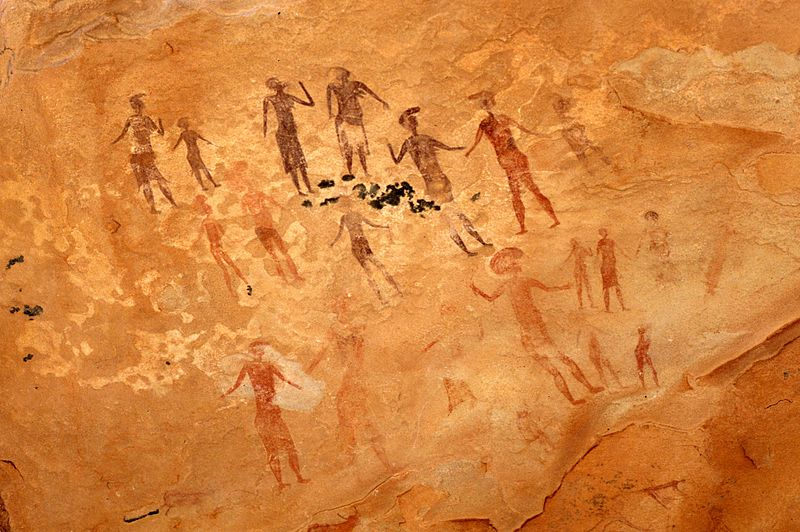
The area’s art has been broken up into phases, the first of which is known as the Round Head Period, created by the later hunter gatherers. These can be figures, metres high, as well as scenes like the above. The two most famous artworks from the site come from this period.
There’s the ‘Running Horned Woman’, a rather literal name, a female figure who may be a dancer or some representation/goddess. As well as her clothing, tens of dots cover her body and the area around her, potentially representing scarification.
She may have represented some of the usual connections of goddesses, painted over earlier smaller figures, and the horns, if that is what they are, would be connected with the growing domestication and pastoral lifestyle. Combined with the elevated position of the artwork’s massif, the painting does seem to be symbolic, holding some sacred meaning, but it’s impossible to know.
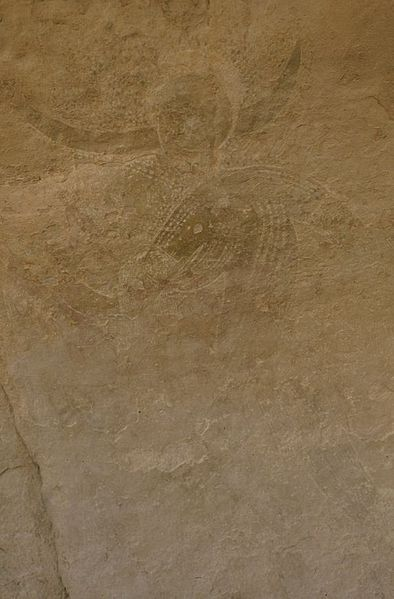
There are better photos of the art and its colours out there, if you’d like to look them up. Sadly the archaeologists who documented the region used water to bring out colours, severely damaging the art, some of which is now completely faded. Here’s a fantastic smart history article with more about the figure and the site’s ‘discovery’.
The artwork then moves more into the pastoral period, with increasingly different styles as the land became more arid, perhaps as different people moved about, with goats and dogs depicted here too. There’s scenes of herders and hunters with bows, like the below.
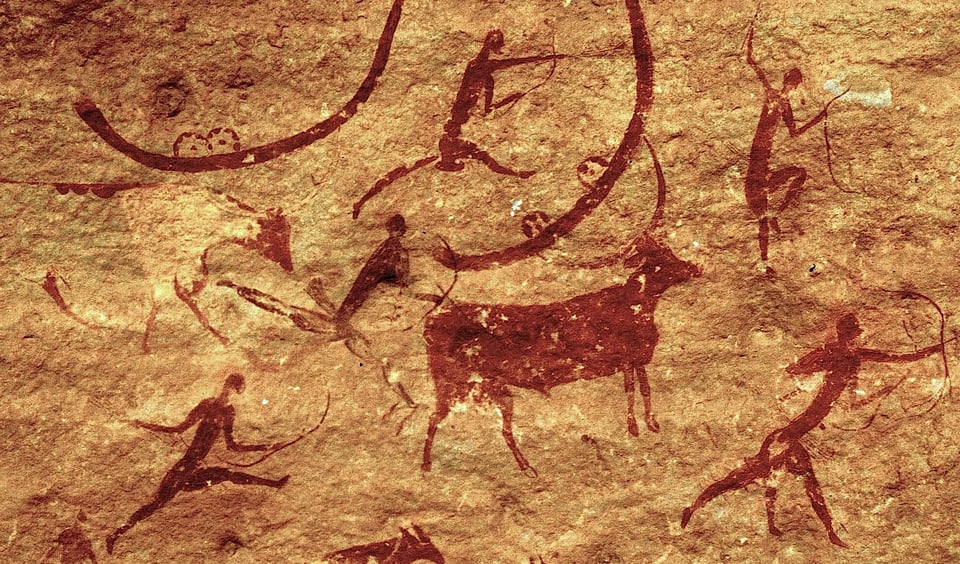
Then came horses and chariots, and an indecipherable ancient script. As long-distance trade routes were established, camels, as well as armed warriors are depicted.
I’ve also found some beautiful engravings from Tin-Taghirt within the park that I’d like to share, both from Wikimedia Commons, photos by Linus Wolf. These are just two highlights, but I think for art so ancient, they posses a real vibrancy, almost like some modern art or even Pictish carvings with the flowing lines.
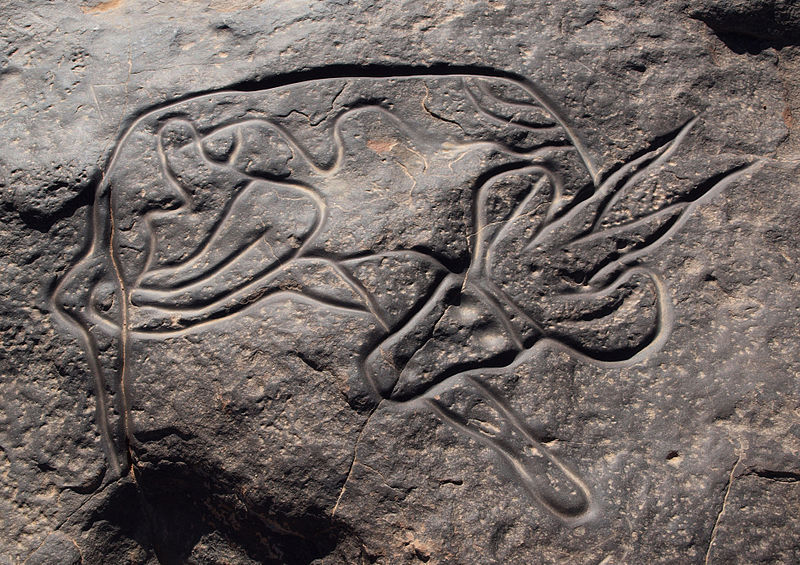
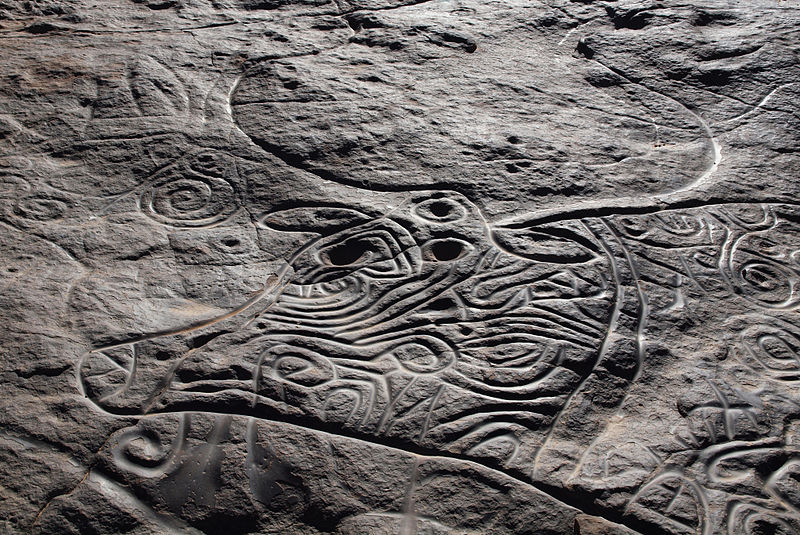
What drew me to the site for story purposes, though, is that there’s perhaps the oldest representation of the use/effects of hallucinogens, or at least some arty fungoid imagery. Whatever the case, they’re certainly striking.
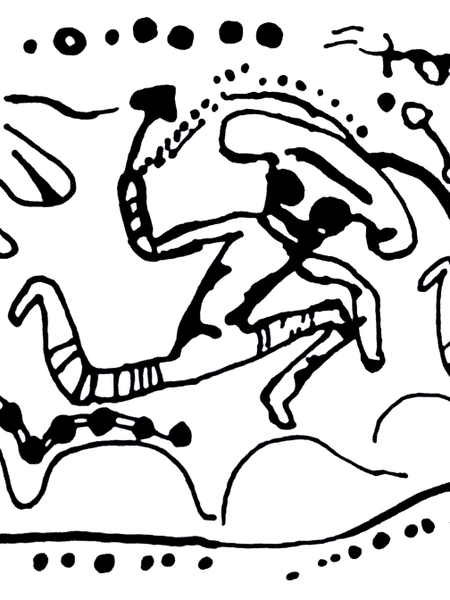
This is but one of a fair few similar figures, leaping about maybe with headdresses or some sort of animal/plant hybrid head. They prance about amidst interesting patterns (more of the art can be seen here) but it’s the almost magical trails moving from what could be mushrooms to their heads which are fascinating, if a little dubious.
But there’s another large figure that’s undisputedly mushroom related, what has been called a shaman, a figure coated with mushrooms that may relate to his visions or may be related to something completely different, another god. Below is another redrawing of the engraving, which in real life has handprints around it, as well as having a more weathered, dotty appearance.
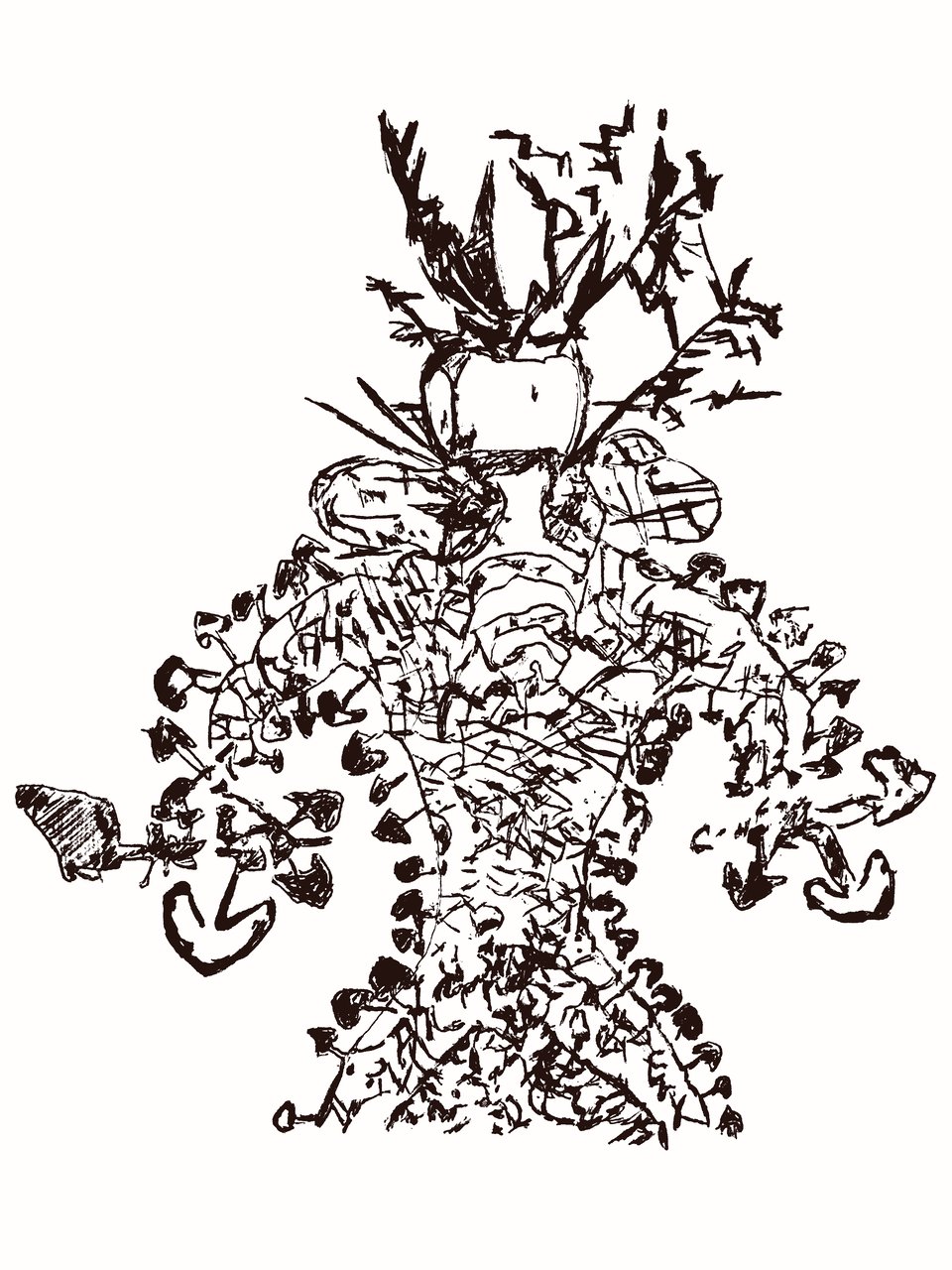
It’s possible they’re wearing a mask evocative of Barbary sheep, like many potential shamans of European art do. If it is a a shaman who ritually used mushrooms, it’s almost like they’re growing from and merging with him in the art.
Here’s a painting of a similar figure also from the site, but who is much more clearly a person in a mask:
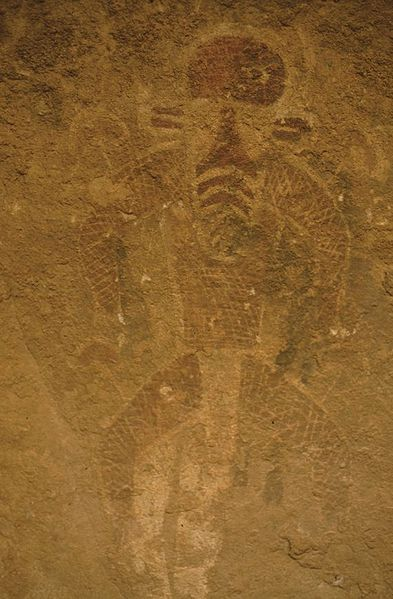
Regardless of meaning, they’re all incredible pieces of art, done by people just like you and me at a time when rock was the canvas, not stained glass or a neon sign. Every piece of art I’ve shared in this series, including the many Star Wars titles, is a part of the same tapestry, really, all some expression of humanity, connection, the first shaman and the last Jedi, stories from A Long Time Ago…
But we’ve reached the end of this exploration, both this post and my numbered series. I hope you enjoyed! I’ve loved the opportunity to share these two facets of my reading/writing life. As I said in the intro, this series will continue in an exciting new direction soon. Thank you for supporting me on this endeavour!
Harvey
